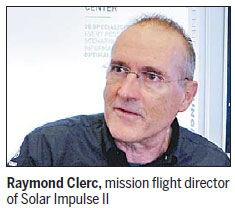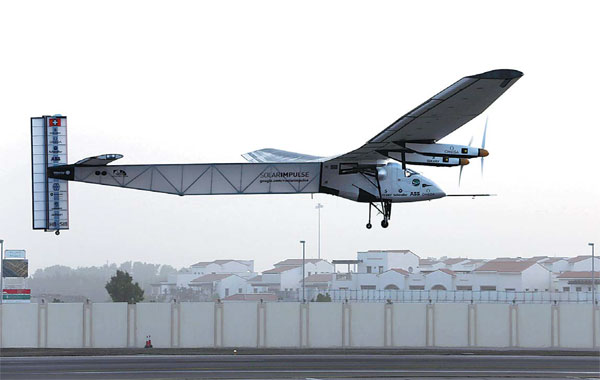Tanked with sun to take on the world

Months-long odyssey that takes in China aims to break solar flight record
China is an important stop along the flight route of Solar Impulse II, the first-ever solar powered plane to fly around the globe, says mission flight director Raymond Clerc.
This is because China is a big market for environmentally friendly technology, so it is important for Solar Impulse II to raise awareness of the project in China, Clerc says.
| The Solar Impulse II takes off at Al Bateen airport in Abu Dhabi, at the start of an attempt to fly around the world. Provided to China Daily |
The Solar Impulse II flight took off in Abu Dhabi at 7:12 am on March 9. It will stop en route in various cities, including Muscat in Oman, Varanasi and Ahmedabad in India, Chongqing and Nanjing in China and Phoenix, Arizona. Stopovers are also planned for Europe and North Africa.
Solar Impulse II is expected to set a new record for flying 40,000 kilometers on solar power alone, a flight expected to take five months. Twenty engineers and specialists are monitoring the flight on numerous video screens at the Monocle Control Center, which is purpose built for this project.
"Mission Control Center is the guardian angel of Solar Impulse II because we receive all the necessary data to keep the plane in the air and keep pilots happy and healthy," says Conor Lennon, Mission Control Center communications manager.
The take-off happened in a matter of seconds, and workers at MCC who watched the live broadcast clapped as the plane took off.
One special guest for the occasion is Albert II, Prince of Monaco, who attended the event to express his support. He wore the MCC uniform and sat amongst the MCC engineers during the take-off.
Prince Albert says it is an honor to host the MCC in Monaco because it is great to have the principality's name associated with the project, as Monaco greatly supports renewable energy.
"Mission Control Center is the guardian angel of Solar Impulse II because we receive all the necessary data to keep the plane in the air and keep pilots happy and healthy," says Conor Lennon, Mission Control Center communications manager.

Lennon says MCC's control team will take care of meteorological data monitoring, air traffic control, mission control and flight strategy control. All this information will be provided to the flight director, who will provide information to the pilot with all the instructions from take-off to landing.
"The meteorological team will look at hundreds of weather patterns, models, forecasts and real time weather. The air traffic control team will coordinate with regional control centers across the flight path and along the flight corridor.
"The mission engineers are looking to see exactly how the flight is operating in the air right now. The flight strategists are people doing simulation and modeling work. They are doing it before the flight and also during the flight, constantly recalculating to make sure they're flying the plane at the most optimal trajectory," Lennon says.
Meanwhile, there are another 20 people working at the MCC on social media and communications, making sure the Solar Impulse II's messages are well communicated and understood for a global audience.
Solar Impulse II goes back to 1999 when Bertrand Piccard, a Swiss scientist and aeronaut, completed a non-stop around-the-world balloon flight.
Aware that a lack of fuel could have caused his adventure to fail, Piccard promised himself that he would circumnavigate the world again, but this time without fuel or polluting emissions. This led to the Solar Impulse project, which began in 2003.
In July 2010, Solar Impulse I took the first ever whole day-and-night flight without fuel. And this year Solar Impulse II will fly across the world in 12 stages, and is to arrive in China next month
While stopping in China, Solar Impulse will host promotional activities, including pilot talks, seminars, meetings with officials from the Chinese government, and opportunities for Chinese people to see the plane for themselves.
Clerc says the project has received enormous support from the authorities and airports in the cities it visits. For example, when Solar Impulse flies into an airport, the runway needs to be cleared for its landing, which means a commercial sacrifice is needed because no other aircraft are able to use the same time slot.
From Nanjing, Solar Impulse will embark on the most challenging and longest leg of its flight, a five-day non stop flight to Hawaii. On this leg, Solar Impulse's eight maximum power point tracking devices are critical, since failure of just one during this long flight could make it impossible to charge batteries enough during daylight while driving motors sufficiently to reach maximum altitude.
Many of the innovative Solar Impulse II technologies can later be commercialized to address environmental problems, says Maxine Ghavi, group senior vice-president and program director for microgrids at ABB, the Swiss power and automation technologies firm.
ABB is the engineering partner for Solar Impulse. Three ABB engineers and 10 staff from ABB's electrical team are in the Solar Impulse team. The ABB team will take care of improving the ground operations control systems and optimizing the electronic chargers for the aircraft's battery systems, amongst other tasks.
"The two organizations have a common vision. We both believe it is important to decouple economic growth with environmental impact, by focusing on energy efficiency and renewable energy," Ghavi says.
Elements of technology such as energy efficiency, energy storage, and efficient conversion from renewable sources to electrical energy are important technology that can be taken from Solar Impulse for commercialization, she says.
Two of the three ABB engineers are part of the electrical and propulsion team at Solar Impulse, helping to extract maximum power yield from the solar panels and making sure the batteries are fully charged.
The third engineer has deployed ABB equipment to improve the reliability of the control system of the mobile hangar that will house the plane if it has to make unscheduled stops. This engineer will be accompanying the Solar Impulse team on its round-the-world journey.
"I applied for the job on the day the opportunity became available, because I think it is so exciting to work on this unprecedented project which will leave its mark in history," says Stevan Marinkovic, an ABB engineer
Marinkovic's main task is designing charging electronics to use the energy from the main power supply for the propellers and ensure that the cockpit battery is always full.
Ghavi says the success of the Solar Impulse project reflects the importance of solar energy as one of many renewables that can help reduce environmental pollution.
"Solar Impulse sends a message about what you can do with solar, but the message is even bigger, beyond solar. It goes more towards renewables as a whole, placing a greater focus on renewables as our energy for the future."
Cost is a key challenge in the switch from conventional energies to renewable energies, but overall the costs of renewable energy over the last four to five years have fallen dramatically, in particular solar energy, she says.
Ghavi says China has an obvious advantage in developing renewable energies due to its resources and its economies of scale.
"With the deployment of solar, scale has increased dramatically and China is realizing some of these benefits as they grow the market. The installation for renewables for China has continued to grow, so we'll say they're really making an impact in terms of growth of the industry."
cecily.liu@chinadaily.com.cn
(China Daily European Weekly 03/13/2015 page19)
Today's Top News
- Japan tempting fate if it interferes in the situation of Taiwan Strait
- Stable trade ties benefit China, US
- Experts advocate increasing scope of BRI to include soft power sectors
- New engine powers cargo drone expansion
- China to boost green industry cooperation
- Manufacturing PMI rises in November































